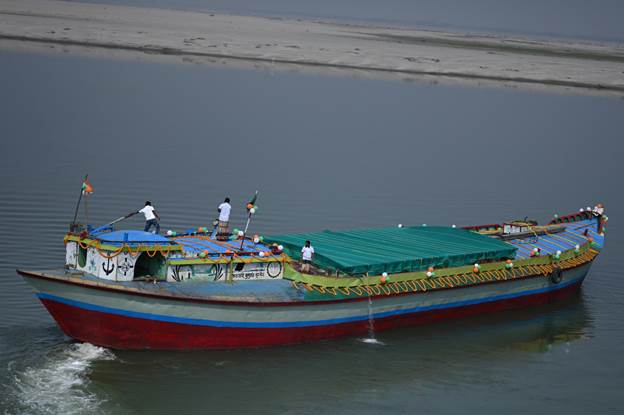 |
| Enhancing Bilateral Connectivity: India-Bangladesh Inland Water Transport Initiative [Source: Logistics & SCM] |
Recently, a significant development in bilateral cooperation between India and Bangladesh unfolded with the inaugural movement of vessels along the Maia-Aricha route. This route connects Maia Port in India to Sultanganj Port in Bangladesh and holds substantial promise for enhancing connectivity between the two nations. The maiden voyage featured the Bangladesh-flagged vessel MV Desh Bangla, carrying stone aggregates, which was ceremoniously flagged off by Minister of State for Ports, Shipping, and Waterways, Shri Shantanu Thakur. This event marks a pivotal milestone, symbolizing the commitment of both countries to deepen their ties and aligning with India’s Act East Policy. The commencement of this trial movement sets the stage for bolstered trade and cooperation, promising mutual benefits for India and Bangladesh alike.
Significance of Enhanced Connectivity: The Chairman of the Inland Waterways Authority of India (IWAI) highlighted the potential impact of consistent cargo flow from the Maia terminal. It is expected to boost trade not only with Bangladesh but also with the North Eastern states, fostering new economic opportunities. Moreover, the Maia-Aricha route is set to shorten the distance between National Waterway-1 and Bangladesh and North East India by an impressive 930 km, compared to conventional roadways.
Bilateral Trade Enhancement: In a move to enhance bilateral trade, Bangladesh has consented to five trial runs between Maia and Sultanganj. This demonstrates the viability of waterways as a mode of transportation and marks a promising beginning for increased connectivity and cooperation between the two neighboring countries.
India’s Efforts in Inland Water Transport: The Ministry of Ports, Shipping, and Waterways, through the IWAI, has embarked on numerous infrastructure projects along National Waterway-1 and the Indo-Bangladesh Protocol routes to enhance regional connectivity. The operationalization of the Maia terminal is a significant breakthrough, expected to shift a substantial 2.6 million tonnes per annum of Bangladesh exports from road to water transport.
Maritime Development in West Bengal: Over the past decade, West Bengal has witnessed significant progress in maritime and inland waterways development. Under the Sagarmala Programme, the state has seen the implementation of 62 projects worth Rs.16,300 crore, with 19 already completed. Furthermore, 11 projects amounting to Rs.650 crore have received partial funding, with 6 already completed.
Future Prospects: Although inland water transport is highly cost-effective for bulk cargo movement, its current modal share in India remains low at 2%. However, the Maritime India Vision 2030 aims to boost this to 5% by developing 25 new National Waterways. The Amrit Kaal Vision 2047 outlines 46 initiatives to enhance coastal and inland water transport share, including the operationalization of 50 waterways and the introduction of efficient vessel designs. Proposed policy measures include reducing port charges, providing fiscal incentives for water transport, and lowering GST for multimodal logistics. These initiatives are geared towards achieving a more efficient and sustainable transportation network by 2047.
